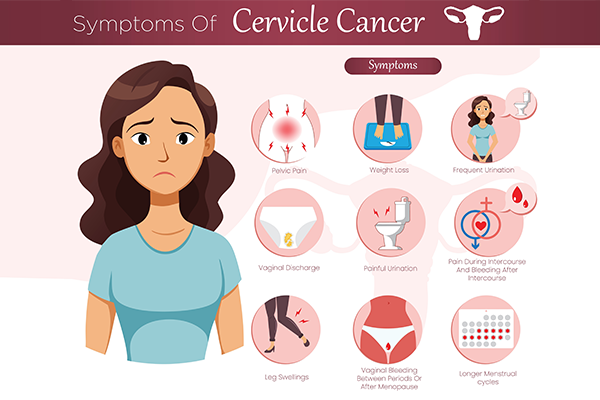
Cervical cancer isn’t rare, but it’s also one of the most preventable and treatable cancers if caught early. Understanding what cervical cancer is, knowing the symptoms of cervical cancer, and going for regular checks matter more than you think. It’s not just about avoiding illness—it’s about being in charge of your future.
If you’re due for a check-up or concerned about any signs, reach out to our highly experienced oncologists in Delhi. Their cervical screening, treatment, and compassionate guidance can help turn concern into clarity.
Synopsis
What Is Cervical Cancer?
It’s a type of cancer that begins in the cervix—that’s the lower part of the uterus that opens up into the vagina. It usually develops slowly, often starting with changes to the cells in the cervix. Most of the time, these changes are caused by a long-term infection with certain types of human papillomavirus, or HPV for short.

Spotting the Symptoms of Cervical Cancer
One of the trickiest things about cervical cancer symptoms is that they might not be obvious early on. You might feel completely fine and have no idea something’s going on. But in later stages or sometimes even in precancerous stages, your body might try to tell you something’s wrong.
Keep an eye out for:
-
Bleeding between periods, after sex, or following menopause
-
Vaginal discharge that smells odd or looks unusual
-
Pain during sex
-
Pelvic or back pain that doesn’t come and go with your cycle
-
Periods that feel out of the ordinary; longer, heavier, or painful
Not every unusual sign means it’s cancer, but if these things keep happening or feel new, it’s always better to check. Catching it early makes cervical cancer treatment a lot more manageable.
Cervical Cancer Causes You Should Know
Most people hear “HPV” and instantly worry—and understandably so. Certain strains of HPV are indeed the leading cervical cancer. But it’s worth knowing that HPV is incredibly common. Most sexually active people will contract it at some point, often without any symptoms.
Still, in some cases, the virus doesn’t go away like it normally should. When that happens, it can trigger abnormal cell changes, which (over several years) may turn into cancer.
Other possible cervical cancer causes include:
-
Smoking (which can interfere with your body’s ability to fight infection)
-
A weakened immune system
-
Starting sexual activity young or having multiple partners
-
Having many full-term pregnancies
-
Long-term use of hormonal contraception
Knowing this stuff helps—not to scare you—but to make smarter choices.
How to Prevent Cervical Cancer
There are some real, practical steps you can take when it comes to preventing cervical cancer.
Here’s what makes a big difference:
-
HPV vaccination: It plays a massive role in stopping high-risk HPV types from causing abnormal cell growth.
-
Regular Pap tests and HPV screenings: These find early signs, before anything becomes cancer.
-
Avoid smoking: It helps your body stay stronger.
-
Use protection during sex to limit exposure to HPV.
If you’re not sure where to get a screening or vaccine, we are here to provide comprehensive cervical health services that are reliable and respectful.
How to Detect Cervical Cancer
How to detect cervical cancer when you don’t feel anything weird?
Screenings, not guesswork.
A few key tests are used to spot trouble:
-
The Pap smear, which looks for weird or changed cells in the cervix
-
The HPV test, which checks for the high-risk virus itself
-
Colposcopies, which take a closer look at the cervix if something seems off
-
If needed, a biopsy can confirm precisely what’s happening
We provide expert-led gynaecology care, where these tests are performed with care, privacy, and a great deal of empathy.
How to Detect Cervical Cancer at Home
Let’s be honest: You can’t do an official test on yourself. But you can stay clued in. If you're wondering how to detect cervical cancer at home, it’s more about monitoring than testing.
Pay attention to your symptoms:
-
Is there odd bleeding?
-
Are you seeing changes in discharge?
-
Have you had pelvic pain lately?
And that’s where you act. You spot the signs, then head to your doctor for proper screening. Keeping an eye on your gynaecological health is one of the best habits you can build.
So while you can’t perform a Pap smear yourself, knowing how to detect cervical cancer at home means being aware and proactive.
Cervical Cancer Treatment Options
Let’s say an actual diagnosis happens. What next?
Cervical cancer treatment depends on a few things: how early it was caught, your overall health, and your plans (like whether you want children later).
You might be looking at:
-
Surgery: Sometimes, it’s as simple as removing part of the cervix (or all, if needed)
-
Chemotherapy: Targets and kills cancer cells
-
Radiation Therapy: Focused beams to shrink or destroy tumours
-
Targeted Therapies: Treatments that go after cancer in very specific ways
Our oncologists in Delhi work together to create a customised plan for your body and your life.
FAQ's
Cervical cancer starts in the cervix and is often linked to long-term HPV infection. Anyone sexually active is technically at risk, but regular testing can reduce that risk significantly.
Key cervical cancer symptoms include unusual vaginal bleeding, discomfort during intercourse, and persistent pelvic pain. If something doesn’t feel right, it's best to see your GP.
If you are wondering how cervical cancer can be detected early, routine Pap tests and HPV screenings are critical. They help spot changes long before cancer takes hold.
You can’t diagnose it without clinical tests, but knowing how to detect cervical cancer at home means noticing consistent irregular bleeding, a change in discharge, or pelvic discomfort, and getting it checked.
If you’re asking how to prevent cervical cancer, the key steps are HPV vaccination, regular screening, not smoking, and protecting yourself during sex. These small choices protect your bigger future.





















 5 Min Read
5 Min Read






_Early_Detection.png)









